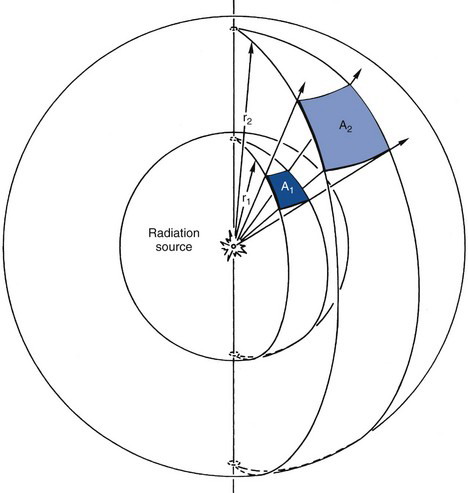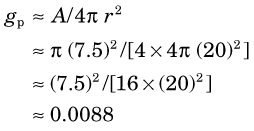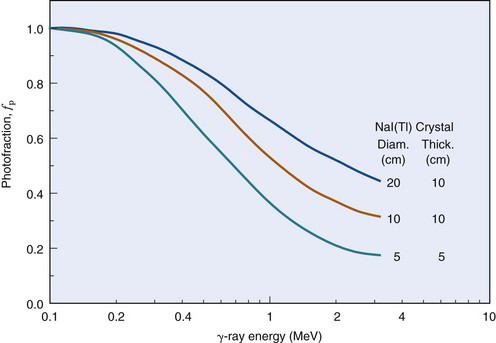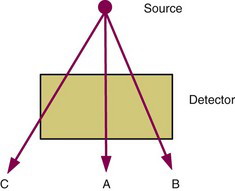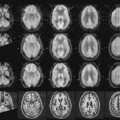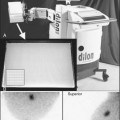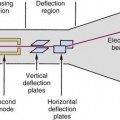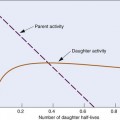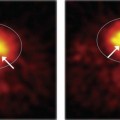chapter 11 Problems in Radiation Detection and Measurement
Nuclear medicine studies are performed with a variety of types of radiation measurement instruments, depending on the kind of radiation source that is being measured and the type of information sought. For example, some instruments are designed for in vitro measurements on blood samples, urine specimens, and so forth. Others are designed for in vivo measurements of radioactivity in patients (Chapter 12). Still others are used to obtain images of radioactive distributions in patients (Chapters 13, 14, and 17–19).
A Detection Efficiency
1 Components of Detection Efficiency
In general, it is desirable to have as large a detection efficiency as possible, so that a maximum counting rate can be obtained from a minimum amount of activity. Detection efficiency is affected by several factors, including the following:
In theory, one therefore can describe detection efficiency D as a product of individual factors,
where g is the geometric efficiency of the detector, ε is its intrinsic efficiency, f is the fraction of output signals from the detector that falls within the pulse-height analyzer window, and F is a factor for absorption and scatter occurring within the source or between the source and detector. Each of these factors are considered in greater detail in this section. Most of the discussion is related to the detection of γ rays with NaI(Tl) detector systems. Basic equations are presented for somewhat idealized conditions. Complications that arise when the idealized conditions are not met also are discussed. An additional factor applicable for radionuclide imaging instruments is the collimator efficiency, that is, the efficiency with which the collimator transmits radiation to the detector. This is discussed in Chapter 13.
2 Geometric Efficiency
where ξ is the emission rate of the source and r is given in centimeters. As distance r increases, the flux of radiation decreases as 1/r2 (Fig. 11-1). This behavior is known as the inverse-square law. It has important implications for detection efficiency as well as for radiation safety considerations (see Chapter 23). The inverse-square law applies to all types of radioactive emissions.
The inverse-square law can be used to obtain a first approximation for the geometric efficiency of a detector. As illustrated in Figure 11-1, a detector with surface area A placed at a distance r from a point source of radiation and facing toward the source will intercept a fraction A/4πr2 of the emitted radiation. Thus its geometric efficiency gp is
Answer
The area, A, of the detector is
Therefore, from Equation 11-6,
Thus the detector described in Example 11-1 intercepts less than 1% of the emitted radiation and has a rather small geometric efficiency, in spite of its relatively large diameter. At twice the distance (40 cm), the geometric efficiency is smaller by another factor of 4.
Equation 11-6 becomes inaccurate when the source is “close” to the detector. For example, for a source at r = 0, it predicts gp = ∞. An equation that is more accurate at close distances for point sources located on the central axis of a circular detector is
where θ is the angle subtended between the center and edge of the detector from the source (Fig. 11-2). For example, when the radiation source is in contact with the surface of a circular detector, θ = 90 degrees and gp = 1/2 (Fig. 11-3A).

FIGURE 11-2 Point-source geometric efficiency for a circular large-area detector placed relatively close to the source depends on the angle subtended, θ (Equation 11–7).
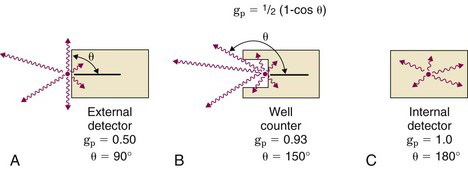
FIGURE 11-3 Examples of point-source geometric efficiencies computed from Equation 11-7 for different source-detector geometries.
Geometric efficiency can be increased by making θ even larger. For example, at the bottom of the well in a standard well counter (Chapter 12, Section A.2) the source is partially surrounded by the detector (Fig. 11-3B) so that θ ≈ 150 degrees and gp ≈ 0.93. In a liquid scintillation counter (see Chapter 12, Section C), the source is immersed in the detector material (scintillator fluid), so that θ = 180 degrees and gp = 1 (Fig. 11-3C).
Equation 11-7 avoids the obvious inaccuracies of Equation 11-6 for sources placed close to the detector; however, even Equation 11-7 has limitations when the attenuation by the detector is significantly less than 100%. This problem is discussed further in Section A.5.
The approximations given by Equations 11-6 and 11-7 apply to point sources of radiation located on the central axis of the detector. They also are valid for distributed sources having dimensions that are small in comparison to the source-to-detector distance; however, for larger sources (e.g., source diameter  0.3r) more complex forms are required.1
0.3r) more complex forms are required.1
3 Intrinsic Efficiency
where µl (E) is the linear attenuation coefficient of the detector at the γ-ray energy of interest, E, and x is the detector thickness. In Equation 11-9 it is assumed that any interaction of the γ ray in the detector produces a potentially useful signal from the detector, although not necessarily all are recorded if energy-selective counting is used, as described in Section A.4.
The mass attenuation coefficient µm versus E for NaI(Tl) is shown in Figure 6-17. Numerical values are tabulated in Appendix D. Values of µl for Equation 11-9 may be obtained by multiplication of µm by 3.67 g/cm3, the density of NaI(Tl). Figure 11-4 shows intrinsic efficiency versus γ-ray energy for NaI(Tl) detectors of different thicknesses. For energies below approximately 100 keV, intrinsic efficiency is near unity for NaI(Tl) thicknesses greater than approximately 0.5 cm. For greater energies, crystal thickness effects become significant, but a 5-cm-thick crystal provides ε > 0.8 over most of the energy range of interest in nuclear medicine.
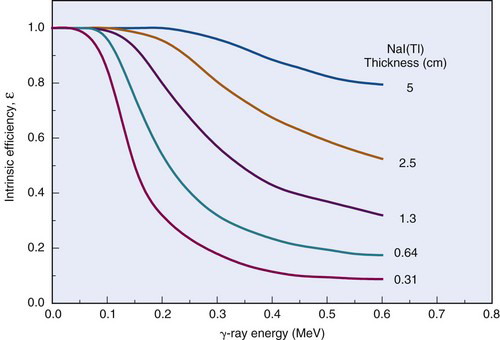
FIGURE 11-4 Intrinsic efficiency versus γ-ray energy for NaI(Tl) detectors of different thicknesses.
The intrinsic efficiency of semiconductor detectors also is energy dependent. Because of its low atomic number, silicon (Si, Z=14) is used primarily for low-energy γ rays and x rays ( 100 keV), whereas germanium (Ge, Z=32) is preferred for higher energies. The effective atomic number of NaI(Tl) is approximately 50 (Table 7-2), which is greater than either Ge or Si; however, comparison with Ge is complicated by the fact that Ge has a greater density than NaI(Tl) (ρ = 5.68 g/cm3 vs. 3.67 g/cm3). The linear attenuation coefficient of NaI(Tl) is greater than that of Ge for E
100 keV), whereas germanium (Ge, Z=32) is preferred for higher energies. The effective atomic number of NaI(Tl) is approximately 50 (Table 7-2), which is greater than either Ge or Si; however, comparison with Ge is complicated by the fact that Ge has a greater density than NaI(Tl) (ρ = 5.68 g/cm3 vs. 3.67 g/cm3). The linear attenuation coefficient of NaI(Tl) is greater than that of Ge for E  250 keV, but at greater energies the opposite is true; however, differences in cost and available physical sizes favor NaI(Tl) over Ge or Si detectors for most applications. The effective atomic numbers of cadmium telluride (CdTe) and cadmium zinc telluride (CZT) detectors are similar to that of NaI(Tl) (see Tables 7-1 and 7-2). They also have higher densities (ρ ≈ 6 g/cm3). Thus for detectors of similar thickness, these detectors have somewhat greater intrinsic detection efficiencies than Na(Tl).
250 keV, but at greater energies the opposite is true; however, differences in cost and available physical sizes favor NaI(Tl) over Ge or Si detectors for most applications. The effective atomic numbers of cadmium telluride (CdTe) and cadmium zinc telluride (CZT) detectors are similar to that of NaI(Tl) (see Tables 7-1 and 7-2). They also have higher densities (ρ ≈ 6 g/cm3). Thus for detectors of similar thickness, these detectors have somewhat greater intrinsic detection efficiencies than Na(Tl).
Gas-filled detectors generally have reasonably good intrinsic efficiencies (ε ≈ 1) for particle radiations (β or α) but not for γ and x rays. Linear attenuation coefficients for most gases are quite small because of their low densities (e.g., ρ ≈ 0.0013 g/cm3 for air). In fact, most gas-filled detectors detect γ rays primarily by the electrons they knock loose from the walls of the detector into the gas volume rather than by direct interaction of γ and x rays with the gas. Intrinsic efficiencies for Geiger-Müller (GM) tubes, proportional counters, and ionization chambers for γ rays are typically 0.01 (1%) or less over most of the nuclear medicine energy range. Some special types of proportional counters, employing xenon gas at high pressures or lead or leaded glass γ-ray converters,* achieve greater efficiencies, but they still are generally most useful for γ- and x-ray energies below approximately 100 keV.
4 Energy-Selective Counting
The intrinsic efficiency computed from Equation 11-9 for a γ-ray detector assumes that all γ rays that interact with the detector produce an output signal; however, not all output signals are counted if a pulse-height analyzer is used for energy-selective counting. For example, if counting is restricted to the photopeak, most of the γ rays interacting with the detector by Compton scattering are not counted.
The fraction of detected γ rays that produce output signals within the pulse-height analyzer window is denoted by f. The fraction within the photopeak is called the photofraction fp. The photofraction depends on the detector material and on the γ-ray energy, both of which affect the probability of photoelectric absorption by the detector. It depends also on crystal size (see Fig. 10-8) because with a larger-volume detector there is a greater probability of a second interaction to absorb the scattered γ ray following a Compton-scattering interaction in the detector (or of annihilation photons following pair production). Figure 11-5 shows the photofraction versus energy for NaI(Tl) detectors of different sizes.
If energy-selective counting is not used, then f ≈ 1 is obtained. (Generally, some energy discrimination is used to reject very small amplitude noise pulses.) Full-spectrum counting provides the maximum possible counting rate and is used to advantage when a single radionuclide is counted, with little or no interference from scattered radiation. This applies, for example, to many in vitro measurements (see Chapter 12).
5 Some Complicating Factors
a Nonuniform Detection Efficiency
Equations 11-6, 11-7, and 11-9 are somewhat idealized in that they assume that radiation is detected with uniform efficiency across the entire surface of the detector. In some cases, this assumption may be invalid. Figure 11-6 shows some examples for different trajectories from a point source of radiation. For trajectory A, the thickness of detector encountered by the radiation and employed for the calculation of intrinsic efficiency in Equation 11-9 conforms to what normally would be defined as the “detector thickness” in that equation. However, for trajectory B, a greater thickness is encountered and the intrinsic efficiency is larger. On the other hand, for trajectory C, near the edge of the detector, a smaller thickness of detector material is encountered and the intrinsic efficiency is smaller. Partial penetration of the beam for trajectory C sometimes is called an edge effect.
Thus, unless the attenuation by the detector is “very high” (essentially 100% within a thin layer near the surface), the intrinsic efficiency will vary across the surface of the detector. As well, the detector diameter (or area) used for the calculation of geometric efficiency in Equation 11-6 or 11-7 becomes ill-defined when edge effects are significant. When the complications illustrated in Figure 11-6 are significant, detection efficiency must be calculated by methods of integral calculus, rather than with the simplified equations described thus far. The calculations are complex and a complete analysis is beyond the scope of this text, but they have been analyzed in other books.2 A few practical implications derived from more advanced calculations are presented here.
The nonuniform attenuation illustrated in Figure 11-6 affects both geometric efficiency (edge effects) and intrinsic efficiency. The parameter that accounts for both of these quantities is the total detection efficiency, εt. When idealized conditions apply, this can be obtained simply by multiplying the result of Equation 11-6 or 11-7 by the result from Equation 11-9
It is reasonable to use Equation 11-10 to compute total detection efficiency if the resulting discrepancy from a more exact calculation is “small,” for example, less than 10%. If the discrepancy is larger, then one must consider using the more complex methods of integral calculus.
Figure 11-7 shows three detector profiles with different levels of effect for the trajectories shown in Figure 11-6. As compared with a “box” profile (i.e., one with equal thickness and width), a “wide” profile presents a greater range of potential detector thicknesses (trajectory B in Fig. 11-6
Stay updated, free articles. Join our Telegram channel

Full access? Get Clinical Tree







